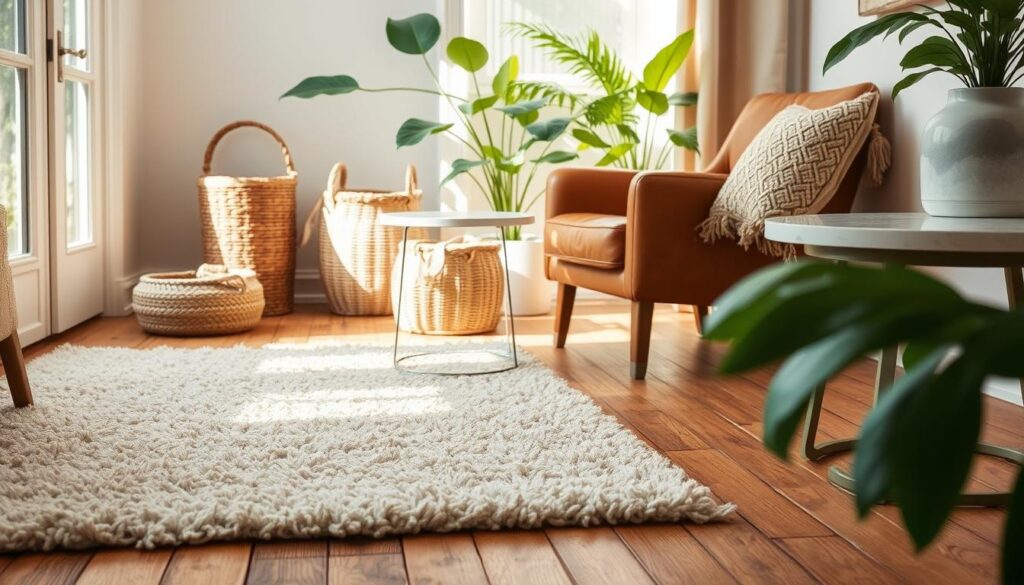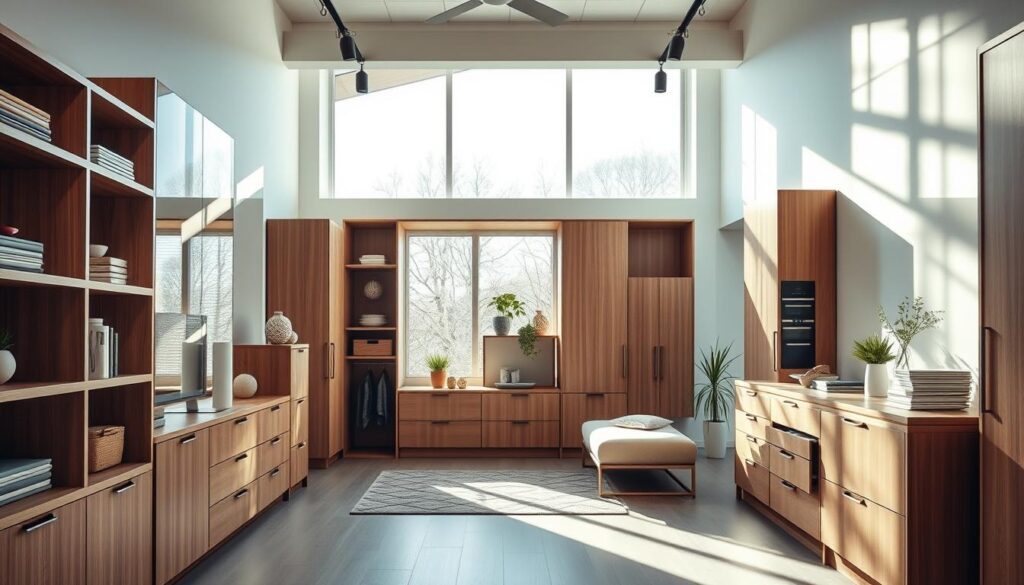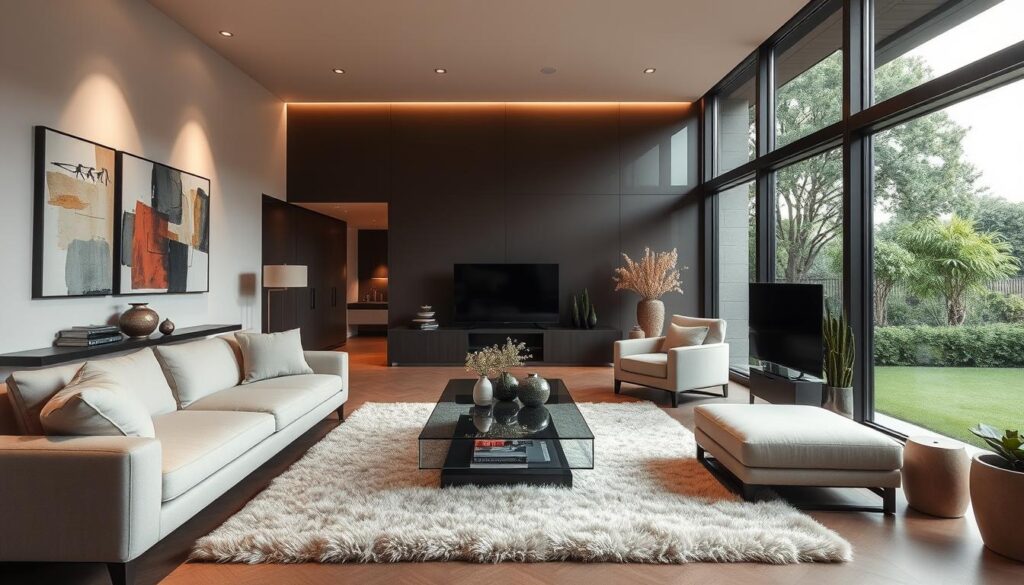Did you know that using the latest modern home decor ideas can boost your home’s value by up to 10%? The world of interior design is always changing. We’ll show you the best ways to make your home stylish, from embracing minimalism to using eco-friendly materials.
We’ll share how to add the newest trends to your home. This includes bold colors, green materials, and furniture that does more than one thing. With our interior design tips, you can make a home that’s both beautiful and practical, showing off your unique style.
Key Takeaways
- Embracing minimalism for a clean and clutter-free space
- Incorporating sustainable materials and practices
- Using bold colors to add personality to your space
- Investing in multifunctional furniture for functionality
- Staying current with the latest interior design trends
Embrace Minimalism in Your Space
Minimalist design is all about simplicity and function. It makes your home calm and free from clutter. This way, your home becomes a place of peace and clear thinking.
Benefits of a Minimalist Approach
Living minimally can make you less stressed and more focused. By keeping only what’s essential, your home becomes tidy and calm. This leads to a life that’s more mindful and free from clutter.
Some key benefits of minimalism include:
- Less clutter and disorganization
- Better mental clarity and focus
- A calmer and more peaceful home
- More productivity and efficiency
Key Elements to Consider
When going minimalist, focus on a few key things. Remove things you don’t need, choose furniture that does more than one thing, and stick to neutral colors.
| Element | Description | Benefit |
|---|---|---|
| Multifunctional Furniture | Furniture that serves more than one purpose | Reduces clutter and increases efficiency |
| Neutral Color Scheme | A palette of calming, neutral colors | Promotes relaxation and serenity |
| Minimal Decor | Limited decorative items that add to the aesthetic | Creates a clean and uncluttered space |
Tips for Decluttering
Decluttering can seem hard, but it’s easier with some tips. Start by sorting items into keep, donate, and discard piles. Be honest with yourself – if you haven’t used it in a year, you probably won’t miss it.
Here are some decluttering tips:
- Begin with one area at a time
- Use storage to hide items
- Remember the 80/20 rule – you likely only use 20% of your stuff 80% of the time
By embracing minimalism and using these tips, you can make your home a peaceful, clutter-free space. It will help you relax and think more clearly.
Integrate Sustainable Design Principles
How we design our homes affects the environment a lot. It’s key to use sustainable interior design to lessen our impact. We aim to make homes that are both lovely and useful.
Using eco-friendly materials and energy-saving ideas helps a lot. It’s good for the planet and makes our homes better for us.
Choosing Eco-Friendly Materials
Choosing the right materials is a big part of sustainable design. Look for materials that are recycled, can be recycled, or are sustainably harvested. For example, reclaimed wood is not only nice to look at but also saves trees.
Other good choices include paints with low VOCs, bamboo floors, and countertops from recycled materials. When buying furniture and decor, pick items made from sustainable sources and made responsibly.
Energy Efficiency in Interior Design
Making our homes more energy-efficient is also key. Using smart lighting, like LED bulbs, is a big help. They use much less energy than old bulbs.
Also, using natural light by placing windows right and adding skylights helps. And, good insulation keeps the temperature steady, so we don’t need to heat or cool as much.
“Sustainability is no longer a choice but a necessity for the future of our planet. By integrating sustainable design principles into our homes, we can create spaces that are not only beautiful but also environmentally responsible.”
By using these sustainable design ideas, we can make homes that are stylish and good for the planet. It’s a step towards a greener future, and every little bit helps.
Create a Cozy Ambiance with Lighting
The right lighting can make a room feel cozy and intimate. It’s a key part of interior design. When done right, it can really improve your space’s look.
Types of Lighting to Consider
There are several lighting types for a cozy feel. These include:
- Ambient lighting, which provides overall illumination
- Task lighting, used for specific tasks like reading or cooking
- Accent lighting, which highlights particular features or areas
Using a mix of these can make your space feel layered and welcoming.
| Lighting Type | Purpose | Examples |
|---|---|---|
| Ambient | Overall illumination | Ceiling fixtures, floor lamps |
| Task | Specific tasks | Table lamps, under-cabinet lighting |
| Accent | Highlight features | Spotlights, string lights |
Layering Light for Depth
Layering light adds depth and interest to a room. Mixing different light sources creates a cozy and inviting space.
For example, combining overhead, table, and floor lamps can make a room warm and welcoming.
Color Temperature and Mood
The color temperature of your lighting affects the room’s mood. Warm white light (2700K-3000K) creates a cozy feel. Cool white light (3500K-5000K) is better for areas where you need to stay alert.
Choosing the right color temperature depends on the space’s use and the mood you want.
Explore the Power of Color Schemes
Colors can change how we feel and act, making color schemes key in interior design. Knowing how colors work and how to mix them can make spaces look good and feel welcoming.
Understanding Color Psychology
Color psychology studies how colors affect us. Each color can make us feel different things. For example, blue makes us calm, while red makes us excited. It’s important to think about how colors will affect people in a space.
To learn more about color psychology in design, check out The Interior Design Institute’s blog on color.
Techniques for Color Coordination
It’s important to mix colors well to create a nice color scheme. Here are some ways to do it:
- Monochromatic: Using different shades of the same color for a unified look.
- Complementary: Pairing colors that are opposite each other on the color wheel for contrast.
- Analogous: Using colors next to each other on the color wheel for a smooth palette.
Accent Walls: When and How to Use Them
Accent walls can make a room more interesting. Painting one wall differently creates a focal point. Choose a color that fits with the room’s overall look and mood.
| Color Scheme | Description | Best Use |
|---|---|---|
| Monochromatic | Different shades of the same color | Creating a cohesive, sophisticated look |
| Complementary | Colors opposite each other on the color wheel | Adding contrast and visual interest |
| Analogous | Colors next to each other on the color wheel | Creating a harmonious, soothing palette |
Incorporate Multifunctional Furniture
Multifunctional furniture is key for small living areas. These pieces do more than one thing. They make small spaces more functional and look better.
Benefits of Versatile Pieces
There are many benefits to using multifunctional furniture. Storage ottomans can be seats and storage. Murphy beds turn a room into a bedroom fast. They save space and keep areas tidy, making small spaces feel bigger.
These items are also very flexible. They meet different needs without needing many items. This is great in places where space is limited, like studio apartments or small homes.
Top Picks for Small Spaces
For small spaces, some furniture stands out. Nesting tables change layout as needed. Storage beds offer a place to sleep and keep things organized.
- Nesting tables for flexible dining and workspace arrangements
- Storage beds that keep clutter at bay
- Ottomans with storage for hidden compartments
- Wall-mounted desks for a dedicated workspace without sacrificing floor space
Using these pieces makes homes more efficient and organized. Even in the smallest homes, they can make a big difference.
Use Textures to Enhance Visual Interest
Textures are key in interior design, adding depth and beauty to any room. Mixing different textures creates a warm and inviting space that stimulates our senses.
Combining Fabrics and Materials
Combining fabrics and materials is a great way to add texture. Pair smooth surfaces like glass or metal with rougher textures like wood or woven fibers. For example, a sleek leather sofa paired with a chunky rug and velvet pillows makes a striking look.
When mixing textures, balance is key. Start with a main texture and add secondary ones that match. For instance, a smooth sofa can be enhanced with throw blankets and pillows in various textures.

Tips for Layering Textures
Layering textures is an art that takes practice. Here are some tips to help you:
- Begin with a neutral base: Use a neutral sofa or rug as your base. Then, add layers with throw blankets, pillows, and more.
- Mix different materials: Combine wood, metal, glass, and fabric for an interesting space.
- Follow the 60-30-10 rule: Use 60% of your space for a main texture, 30% for a secondary one, and 10% for an accent.
Let’s look at some examples of combining textures:
| Texture Combination | Description | Effect |
|---|---|---|
| Smooth + Rough | Pairing a smooth leather sofa with a rough-hewn wooden coffee table. | Creates a striking contrast that adds visual interest. |
| Soft + Hard | Combining soft velvet pillows with a hard metal side table. | Adds depth and creates a cozy yet modern feel. |
| Woven + Smooth | Layering a woven rug under a smooth glass dining table. | Enhances the room’s texture and adds warmth underfoot. |
By carefully combining and layering textures, you can make your home visually stunning and rich in touch.
Add Personal Touches and Artwork
Your home should show who you are. Adding personal touches makes it feel welcoming. Art and unique decor enhance its look and make it yours.
When personalizing home decor, your artwork choice is key. It’s not just about looks. It’s about picking pieces that speak to you.
Choosing the Right Art for Your Space
Choosing art involves several factors. Think about your home’s colors, the room’s purpose, and your taste. For example, a lively piece can energize a living room, while a calm landscape suits a bedroom.
Here are some tips to help:
- Choose art that shows your personality or interests.
- Match the art’s colors with the room’s.
- Feel free to mix styles and textures.
DIY Art Ideas to Personalize Your Home
Making your own art is a great way to personalize your home. DIY art lets you express your creativity and match your decor perfectly. Here are some ideas to start:
One easy project is a gallery wall with family photos or prints. You can also turn old items into art, like vintage windows into mirrors or mosaics from broken tiles.
If you’re up for a challenge, try painting or drawing. You don’t need to be a pro to create something beautiful. The act of making it yourself adds the personal touch.
By adding DIY art and choosing the right artwork, you can make your home truly yours. It’s about showing your personality and making your space a reflection of who you are.
Maximize Space with Smart Storage Solutions
A well-organized home starts with smart storage solutions. These make the most of available space. Effective storage keeps our homes clutter-free and organized.

Creative Storage Ideas for Every Room
Different rooms need different storage. Kitchens need storage for utensils and ingredients. Bedrooms need storage for clothes and personal items. Here are some creative storage ideas for various rooms:
- Under-bed storage for bedrooms to store out-of-season clothes or bedding.
- Hidden compartments in living rooms and kitchens for storing valuable items or keeping clutter out of sight.
- Wall-mounted shelves in any room to add extra storage without taking up floor space.
Utilizing Vertical Space
Using vertical space is a great way to maximize storage. Wall-mounted storage units, tall bookshelves, or storage cabinets that go up to the ceiling are good options. This way, we can increase storage without taking up floor space.
- Install wall-mounted storage units for tools in the garage or for kitchen utensils.
- Use tall bookshelves to store books, decorative items, and other household items.
- Opt for storage cabinets that extend up to the ceiling to maximize storage in kitchens and bathrooms.
By using these smart storage solutions, we can make our homes more organized and clutter-free. They are both functional and pleasing to the eye.
Design for Comfort with Soft Furnishings
The right soft furnishings can make a house feel warm and welcoming. We focus on making our living spaces comfortable. Soft furnishings help us achieve this by adding beauty and coziness.
Selecting the Right Fabrics
Choosing the right fabric for soft furnishings is key. We look at texture, durability, and how easy they are to clean. For example, a velvet sofa can make a room feel luxurious. Cotton or linen can create a casual, airy feel.
Key considerations for fabric selection include:
- Texture: Mixing different textures can add depth to a room.
- Durability: Choosing fabrics that can withstand wear and tear is essential for high-traffic areas.
- Maintenance: Easy-to-clean fabrics are a practical choice for households with pets or young children.
Importance of Comfort in Living Spaces
Comfort is vital in a well-designed living space. Kelly Wearstler, a famous interior designer, said,
“Comfort is not just about physical ease; it’s also about creating an emotional sense of well-being.”
We aim to create spaces that are not only beautiful but also comfortable and relaxing.
By adding soft furnishings wisely, we can make our homes more comfortable. Throw blankets and pillows in calming colors can make a room cozy. A comfy sofa can be the heart of a relaxing living room.
In summary, designing for comfort with soft furnishings is more than just looks. It’s about making a space that promotes relaxation and well-being. By picking the right fabrics and furnishings, we can make our living spaces both stunning and cozy.
Stay Current with Design Trends
Keeping up with design trends can make your home feel new and modern. It’s key to know what’s popular and how to use these elements well.
Current Colors and Patterns
Colors and patterns are big in shaping your space’s look. This season, bold colors and soft pastels are in. Patterns range from geometric to natural textures. We can add these to our decor with furniture, rugs, and wallpaper.
Incorporating Trends with Timeless Style
To not overdo it with trends, mix them with classic pieces. For example, pair a trendy sofa with a classic armchair. Or, use a bold rug with a simple chandelier. For tips on mixing trends with timeless style, check out oumaatelier.com.
By carefully adding design trends, we can make a space that’s both modern and lasting.


